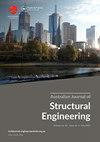热带气旋对西澳大利亚海岸的影响及D区极端风速
IF 1.3
Q4 ENGINEERING, CIVIL
Australian Journal of Structural Engineering
Pub Date : 2021-04-03
DOI:10.1080/13287982.2021.1918376
引用次数: 2
摘要
本文回顾了自1970年以来南印度洋热带气旋的数量,以及影响西澳大利亚皮尔巴拉和加斯科因海岸的登陆气旋,重点介绍了4级及以上强度的热带气旋。它显示,在最近20年里,严重气旋对该海岸线的影响有所减少。在as /NZS 1170.2中,影响目前D区北部边界以外海岸的强气旋几乎与发生在该边界内的气旋一样多,这表明D区可能需要重新评估。8个沿海台站记录和修正的超过22米/秒的极端阵风作为一个组进行处理,3个台站的记录较长。这表明,在没有任何额外因素的情况下,DR AS/NZS 1170.2:2020标准草案中的极值分布是相当充分的,但卡纳文的预测极端风速完全低于D区规范。D区风向乘数计算结果显示,东、东北风向乘数较高;这可以用气旋涡旋产生的顺时针旋转产生的风向来解释,当风暴穿过海岸线时,或者当它们以接近最大的强度沿着海岸线经过时。本文章由计算机程序翻译,如有差异,请以英文原文为准。
Tropical cyclone impacts on the Western Australian coast and extreme wind speeds in Region D
ABSTRACT This paper reviews the numbers of tropical cyclones in the southern Indian Ocean, and the land-falling cyclones that have impacted the Pilbara and Gascoyne coastlines of Western Australia since 1970, with particular emphasis on those of Category 4 strength and above. It shows reductions in impacts of severe cyclones on that coastline in the most recent two decades. Nearly as many severe cyclones have impacted the coast outside the current northern boundary of Region D in AS/NZS 1170.2 as have occurred within that boundary, suggesting the limits of Region D may need reviewing. Recorded and corrected extreme wind gusts exceeding 22 m/s from eight coastal stations have been processed as a group, and individually for 3 stations with long records. This indicates that the extreme value distribution in the draft standard DR AS/NZS 1170.2:2020 is quite adequate, without any additional factors, but the predicted extreme wind speeds for Carnarvon are well under the Region D specifications. The calculated wind direction multipliers for Region D show higher values from east and northeast; this can be explained by the wind directions generated by the clockwise rotations created by the cyclonic vortices, as the storms cross the coastline, or as they pass along the coastline at near full strength.
求助全文
通过发布文献求助,成功后即可免费获取论文全文。
去求助
来源期刊

Australian Journal of Structural Engineering
ENGINEERING, CIVIL-
CiteScore
2.50
自引率
0.00%
发文量
31
期刊介绍:
The Australian Journal of Structural Engineering (AJSE) is published under the auspices of the Structural College Board of Engineers Australia. It fulfils part of the Board''s mission for Continuing Professional Development. The journal also offers a means for exchange and interaction of scientific and professional issues and technical developments. The journal is open to members and non-members of Engineers Australia. Original papers on research and development (Technical Papers) and professional matters and achievements (Professional Papers) in all areas relevant to the science, art and practice of structural engineering are considered for possible publication. All papers and technical notes are peer-reviewed. The fundamental criterion for acceptance for publication is the intellectual and professional value of the contribution. Occasionally, papers previously published in essentially the same form elsewhere may be considered for publication. In this case acknowledgement to prior publication must be included in a footnote on page one of the manuscript. These papers are peer-reviewed as new submissions. The length of acceptable contributions typically should not exceed 4,000 to 5,000 word equivalents. Longer manuscripts may be considered at the discretion of the Editor. Technical Notes typically should not exceed about 1,000 word equivalents. Discussions on a Paper or Note published in the AJSE are welcomed. Discussions must address significant matters related to the content of a Paper or Technical Note and may include supplementary and critical comments and questions regarding content.
 求助内容:
求助内容: 应助结果提醒方式:
应助结果提醒方式:


